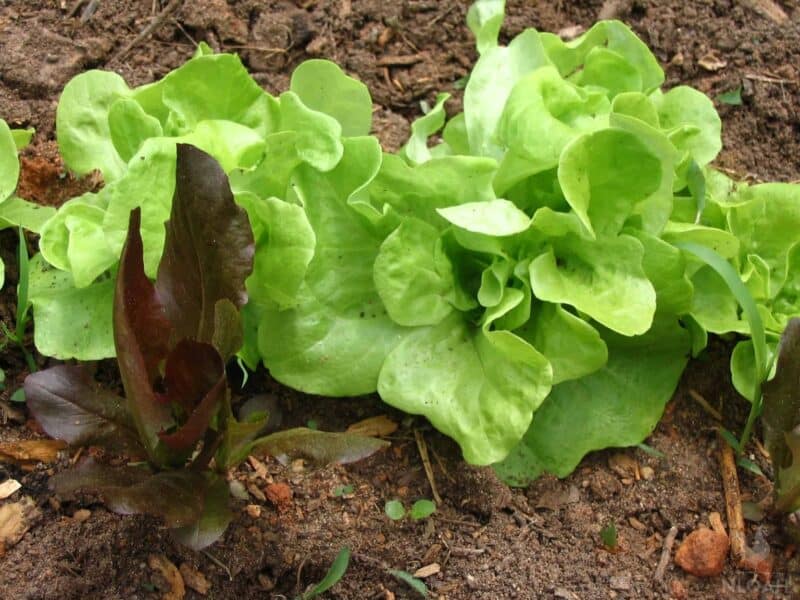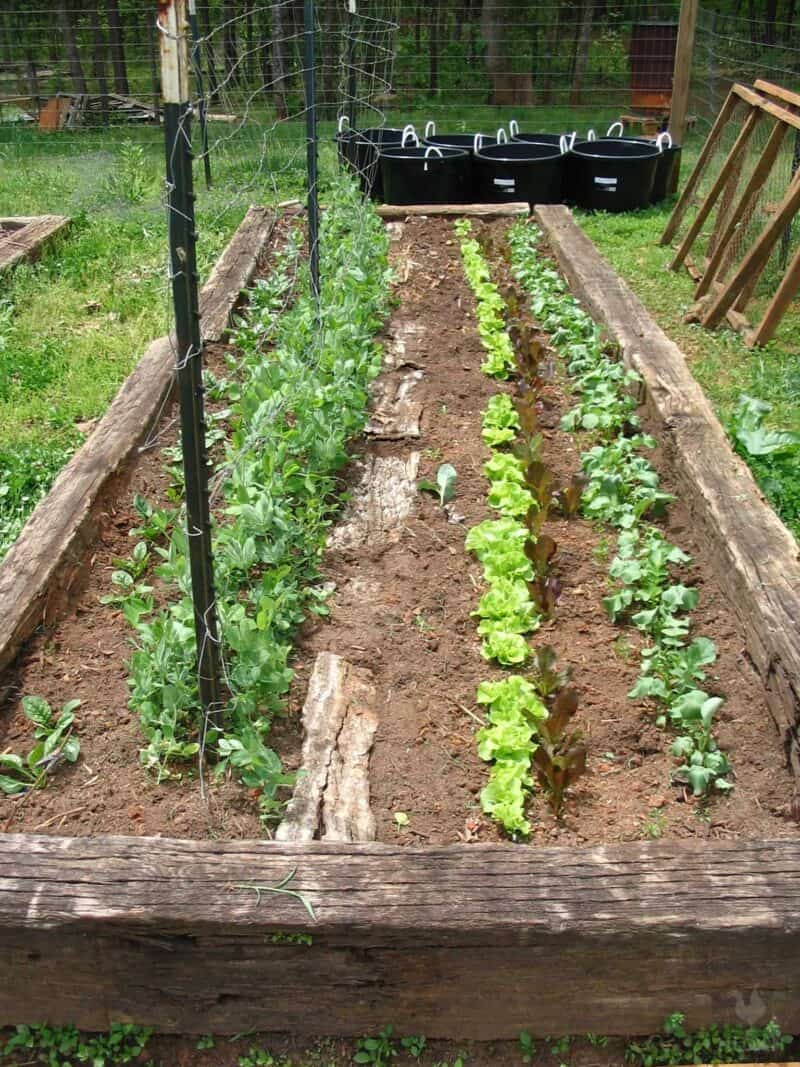Lettuce is a leafy green that is best known for being used in salads. It is a cool-weather plant that does not like the heat.

Lettuce prefers full sun in the morning with some shade in the afternoon. When it comes to how much sun lettuce is needed, it really depends on the type of lettuce you are growing.
Lettuce is a cool-weather plant that does best with some shade in the afternoon… but how much sun does it actually need?
Lettuce needs around 6 to 8 hours of full sun every day. Butterhead and crisphead lettuce needs at least 6 hours, Romaine needs 8 hours, while leaf lettuce can get by with as little as 4 hours, but will grow better with 6.
Those are just ballpark estimates, however. There are countless factors that will influence how much sun your lettuce plants need. Let’s take a closer look!
How Much Sun Does Lettuce Require?
There are four main types of lettuce: butterhead, crisphead, romaine, and leaf.
Butterhead lettuce has loose leaves and a small head. This type of lettuce includes Boston and Bibb lettuce. Crisphead lettuce has tightly packed leaves and a large head. Iceberg lettuce falls into this category.
Romaine lettuce has long thin leaves and forms a tall head. Cos or Romaine lettuce is an example of this type of lettuce. Leaf lettuces have loose leaves and do not form a head. These include Lolla Rossa, Oakleaf, and Red Sails lettuces.
When it comes to how much sun each type of lettuce needs, butterhead and crisphead lettuce need at least six hours of full sun every day. Romaine lettuces need eight hours of full sun every day.
Leaf lettuce can get by with as little as four hours of full sun every day but they will grow better with six hours of full sun every day.
However, those are just basic requirements. You also need to consider the age of the lettuce plants you are growing to get a better picture.
Seeds
Lettuce seeds need very little sunlight to germinate and begin growing. In fact, too much sun can actually inhibit germination.
For best results, sow 2-3 lettuce seeds in a shady spot that receives indirect sunlight or dappled sunlight for only part of the day. Once the seeds have germinated and seedlings have emerged, you can move them into a sunnier spot.
Seedlings
Once your lettuce seedlings have emerged, they will need more sunlight to continue growing. Seedlings should be moved into an area that receives full sun for at least six hours each day.
If you live in a hot climate, it’s best to provide some afternoon shade to prevent your seedlings from getting too much heat.
Fresh Transplants
If you’re transplanting mature lettuce plants from another location, they will need less sun than seedlings since they’ve already been growing for some time.
A new transplanted lettuce plant should be placed in an area that receives full sun for four to six hours each day.
Again, if you live in a hot climate, it’s best to provide some afternoon shade to prevent your plants from getting too much heat.
Mature Plants
Mature lettuce plants need less sun than seedlings or transplants since they’ve been growing for longer and are already fairly established.
A mature lettuce plant should be placed in an area that receives full sun for four hours each day or partial sun for eight hours each day.
If you live in a hot climate, it’s best to provide some afternoon shade to prevent your plants from getting too much heat.
Does Lettuce Need Full Sun?
In general, lettuce does best in full sun. The more sunlight the plants receive, the sweeter and more nutritious the leaves will be.
Lettuce that is grown in partial shade may be less flavorful and more prone to bolting (producing flowers and going to seed).
However, there are some types of lettuce that are more tolerant of shady conditions. For example, mesclun mix is a popular salad green that can be grown in partial shade.

How Many Hours of Sun Does Lettuce Need?
Lettuce plants need at least six hours of sunlight per day in order to produce a good harvest. However, they can also benefit from up to eight hours of sunlight per day.
More than eight hours of sunlight per day can cause the leaves to become bitter and may cause bolting, which is when the plant produces flowers and goes to seed.
The amount of sun required may vary depending on the type of lettuce. For example, iceberg lettuce can tolerate lower light levels than other varieties. In very hot weather, lettuce may benefit from some afternoon shade to prevent wilting.
Can Lettuce Grow in Indirect Sunlight?
Lettuce is a cool-weather crop that thrives in environments with plenty of sunlight and fresh air.
While the plant does need direct sunlight for at least part of the day, too much direct sunlight can cause the leaves to wilt and turn brown. As a result, lettuce is often best suited for growing in areas with indirect sunlight.
There are a few things to keep in mind when growing lettuce in indirect sunlight, however.
First, make sure that the area receives at least six hours of sunlight each day. Second, consider planting your lettuce in a spot that receives morning sun and afternoon shade.
Lastly, make sure to water regularly, as lettuce plants will wilt quickly if they become dehydrated.
Can Lettuce Grow in Shade?
If you only have a shady spot available, you may be wondering if lettuce will still grow there. The answer is yes, but it may not be as abundant or crisp as lettuces grown in sunny areas.
Lettuce needs at least six hours of sunlight per day to produce high yields, so planting it in a shady spot may result in smaller heads of lettuce.
The leaves may also be more prone to disease and pests. If you do decide to grow lettuce in shade, choose a variety that is specifically labeled as being tolerant of low-light conditions.
Can Lettuce Get Too Much Sun?
While most plants need sunshine to grow, too much sun can actually be harmful. For example, lettuce is a cool-weather crop that thrives in partial shade. If it gets too much sun, it will bolt, meaning that it will produce a flowering stalk and go to seed.
When this happens, the leaves become tough and bitter, making them unappetizing to eat. In addition, hot weather can cause the lettuce to wilt and turn brown at the edges.
While there are some varieties of lettuce that are more heat-tolerant, it is generally best to grow lettuce in a spot that gets only a few hours of sunlight each day. This way, you can enjoy crisp, delicious lettuce all season long.
Does Lettuce Prefer Morning or Afternoon Sun?
This is a question that many gardeners have, as the answer can help to determine the best time of day to plant lettuce.
While there are several factors that can affect how lettuce grows, the amount of sunlight it receives is one of the most important.
Lettuce that is grown in full sun will usually have a more robust flavor, while lettuce that is grown in partial shade will be more delicate.
The best way to determine whether morning or afternoon sun is best for your lettuce is to experiment and see what works best in your garden.
Try planting some lettuce in both morning and afternoon sun and see how each plant responds.
You may find that one type of lettuce prefers the morning sun while another does better in the afternoon. Or you may find that your lettuce plants are happy with either type of sunlight. The only way to know for sure is to try it out and see what works best in your garden.
Transitioning Lettuce From Indoors to Sunlight
Lettuce is a cool-weather crop that is typically grown outdoors in the spring or fall. However, it can also be grown indoors under artificial lighting. If you start your lettuce indoors, you will need to take care when transitioning it to sunlight.
Lettuce plants are susceptible to sunburn, so they should be introduced to direct sunlight gradually. Start by placing them in a shady spot for a few hours each day, and then gradually increase the amount of time they spend in the sun.
Once they are acclimated to the light, you can plant them in a sunny spot in your garden.
What Happens if Lettuce Doesn’t Get Enough Sun
Lettuce is a cool-weather crop that thrives in full sun. In fact, the leaves of most lettuce varieties will start to turn yellow or brown if they don’t get enough sunlight.
While this may not seem like a big deal, it can actually have a significant impact on the flavor and nutritional content of the lettuce.
Sunlight helps to convert the plant’s carbohydrates into sugar, which gives the lettuce its sweetness. In addition, sunlight helps to produce carotenoids, which are important for human health.
So, while you may be tempted to save a little money by growing your lettuce in partial shade, you’ll be sacrificing flavor and nutrition in the process.
Follow the tips above for figuring out how much sun your lettuce plants need, and you’ll enjoy flavorful and nutritious leafy greens all season long!


Rebekah is a high-school English teacher n New York, where she lives on a 22 acre homestead. She raises and grows chickens, bees, and veggies such as zucchini (among other things).
